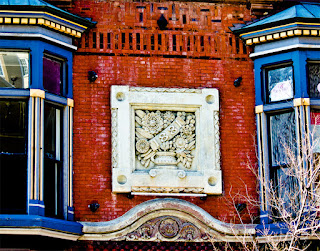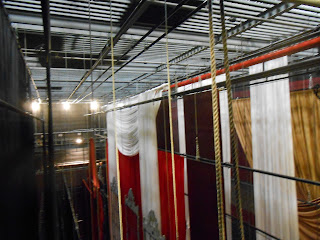For the first
week of my exchange, I spent most of my time getting acquainted with the theater
spaces and some of the people working here at the Shakespeare Theatre
Company (STC.) By the second week I was involved in the nitty gritty of working shows
in the Sydney Harman Hall.
The last performance of FELA! was on
Sunday 2/10. Immediately following the performance, we got straight to
work loading out the scenery and clearing the space for the Washington Ballet
to start loading in the next day. The FELA! touring crew
(which is an IATSE union crew) led the twenty or so non-union STC overhire stagehands
during the strike. During a Union work call, people are assigned
positions which they stick to for the entire call. There are Loaders,
who stay on the loading truck to tightly pack all the boxes of equipment together; Pushers, who stay on deck to load up equipment and strike soft goods
and other pieces of scenery; Down Riggers, who work with packing chain motors
and loading weights on the rail, and Up Riggers, who stay in the grid to detach
various dead hung pieces. I was an Up Rigger for the call, so I didn't
get to see much of what other stagehands were doing, save for what I could see
from the grid.
As an Up Rigger,
me and one other stagehand, were responsible for lowering in dead hung
masking, which was tied off through a device called a "Rabbit
Ear". This has a hole where the line comes up and a cinching lever
that has an arm that doubles as a cleat to tie off the line. I had never
seen this device before, but it is easy to make and it gave me some inspiration
as to how we might be able to integrate the principle into the Angus Bowmer Theatre grid at OSF.
Once the masking was down, we then began the slow process of lowering chain
motors to the deck. The FELA! tour put up about 20 chain
motors for various purposes, mostly to hang electrics
trusses. These trusses were hung from "barrels," which are large
pieces of pipe that lay across the grid ribbons. The motors themselves were
hung from 3/8" aricraft cable swagged on both ends. The
work was slow because we couldn't lower the motors until
the electricians struck the truss from said motors, so I spent most of the 5 hour call looking around the Harman
grid and talking about the industry with the other Up Rigger, who is a seasoned
stagehand. This was insightful because I learned how
flexible a non-union stagehand can be. For example, an
IATSE stagehand CANNOT touch any other department's equipment, no matter how
helpful it may be to the entire process; it is against the rules.
Looking back on OSF's production of The White Snake for example, one stagehand moved a wardrobe cart through the hallway to its track at the beginning and end of each performance to assist the costumers. This would be a complete NO-NO for
an IATSE stagehand.
I was given the day
off for the Monday load-in of the Washington Ballet, due to the fact that I
would be working six days in a row for the performance. Tuesday and
Wednesday were tech days which lasted about 14 hours each: about 12 hours of tech rehearsals and taking care of various notes and two hours for lunch and dinner. During the performance, I was assigned to the flyrail with
three other people. During the first half of
the performances there were as many 4 fly moves happening at one time. The
first piece was Dangerous Liaisons , a play that was adapted by a
choreographer into a 1 hour ballet. After a fifteen minute intermission, there were two more pieces which lasted about 35 minutes in total. At the
end of the second short piece, I had a cue to fly in a blackout
drop a distance of about 20 feet slowly over the course of one song, which was
about 3:30. All of their fly rail is set in a "double
purchase" which means that when you fly the piece, the arbor moves half as
much as the batten. So for 20 feet of batten to travel in, I had to move
the arbor only ten feet over the course of 3:30, which is REALLLLY slow.
The trouble was finding the right speed to time the fly move with the length of the song. The timing was very difficult to achieve, but by opening, I had it
down to near perfection. We had one preview on Wednesday night, opened
Thursday, ran a night show on Friday, with two shows on Saturday and
Sunday. On Tuesday 2/19 we will be changing some of the flying pieces to
prepare for one more week of the Washington Ballet running a new show. We
will be doing the same performance schedule as this past week.
Chris Perme





























.JPG)







